§1. INTRODUCTION
The Cultural exchange between China and the West has an ancient origin, nonetheless, more recently, it can be said that China's Cultural exchanges with the West began with the entry of the Portuguese into Macao, at the time the territory was leased to them, in 1553, in the Ming Dynasty (Jiajing 32). Afterwards, the Spanish, Dutch and English arrived in China and began to establish commercial, political and Cultural relations with the Empire of the Middle. Their relations influenced and promoted the development of the Cultures involved in this process. In the historical period between the middle of the sixteenth century and the end of the eighteenth century, Macao was not only a commercial transit port between the East and the West, but it was also a bridge for Cultural linkage and interpenetration between China and the West and emissaries from European countries who arrived there.
This article seeks to shed some light on the process and the laws, which can today be delineated, of Cultural exchange between China and West during this period. The term, Cultural, is used in this article in the most restrictive sense of its meaning, including, as is normal, philosophy, sciences, technology, literature, fine arts, music and religion, as well as that related to moral values.
§2. THE JESUITS, AS INTERMEDIARY IN THE CULTURAL EXCHANGE BETWEEN CHINA AND THE WEST
A commercial route may simultaneously be one of Cultural exchange. Soon after 1553 -the year in which the Portuguese arrived in Macao and the territory was leased to them by China - three international commercial routes were opened, specifically: Macao-Goa-Lisbon, Macao-Nagasaki and Macao-Manila-Mexico. As a consequence, Western traders, namely from Portugal and Spain, began to come to Macau, because the territory permitted them to get rich through business. Along with the traders, the Jesuits also arrived in Macao and it was through Macao that they began to penetrate into China, with the aim of establishing missions.
In 1556 (Jiajing 35), Gregório Gonzales became the first Catholic priest to arrive in Macao. In 1560 and 1561 (Jiajing 39 and 40), there arrived in Macao, successively, Fr. Baltasar Gago, who was living as a missionary in Japan, Francisco Perez, Fr. Manuel Teixeira and Br. André Pinto, who built missions in this territory and established, in 1565 (Jiajing 44), the local headquarters for the Society, which was to later became the College of St. Paul.
In 1568 (Longqing 2), Juan Batista Ribera and Pedro Boaventura Ribera arrived in Macao. In 1568, according to an incomplete statistics there were more than ten Jesuits in Macau who had come to establish missions in China and Japan. In view of the growth of missionary activities in Macao, Pope Pius V named Bp. of Macao Melchior Carneiro. In May 1568, Melchior Carneiro arrived at Macao and founded a Church, dedicated to St. Lazarus, which was to become the base for the local Santa Casa da Misericórdia (Miserycordy). Later, the St. Lazarus and the St. Raphael Hospitals took in abandoned children and treated the sick. At the request of King Dom Sebastião and in view of the recent development of the missions, on the 25th of January 1576, Pope Gregorio XIII promulgated a Bull ordering the establishment of the Diocese of Macao, directly subordinated to the Bishophry of Goa. Its major function was to administer the missionary affairs in China, Japan and Hainan (present day Vietnam).
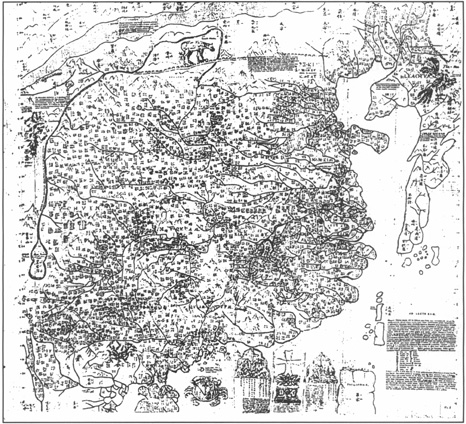 Map of the Zhongguo Tu (Middle Kingdom), attributed to Michael Boym.
Famous manuscript map of China; the first made by the Jesuits to introduce China to the Europeans.
Michael Boym was a Polish Jesuit who arrived in China, in 1643.
Map of the Zhongguo Tu (Middle Kingdom), attributed to Michael Boym.
Famous manuscript map of China; the first made by the Jesuits to introduce China to the Europeans.
Michael Boym was a Polish Jesuit who arrived in China, in 1643.
In 1578 (Wanli 6), Fr. Alessandro Valignano, in his role as Visitor of the Society of Jesus in the Orient, went to Macao to inquire about the functioning of the missionary work. There he was informed that the principal reason why some Jesuits did not manage to enter China to establish missions and saw themselves obliged to stay in Macao, was that they did not know Chinese. Valignano sent a letter to the Father Superior of India, in Goa, Vicente Ruiz, asking and recommending enthusiastically that Michele Ruggieri - who defended the use of the Chinese language in the China missions - to be sent as a missionary to Macao. Once the requested authorization was obtained, on the 22nd of July 1579, Michele Ruggieri arrived in Macao. Here he learned the Chinese language from a Chinese traditional painter and Bp. Melchior Carneiro apprised him about Chinese social manners:
"When you meet a superior, you must kneel down, you must touch the earth with your forehead as a sign of reverence, staying that way for some time; when you speak about third parties, you must use a tone of praise; when you speak about yourself, you must use humble words and phrases."1
Michele Ruggieri spent two years and two months in Macao, learning Chinese; managing to read and write more than twelve thousand characters and mastering the most common social manners and daily customs, in China. Thus, taking advantage of the opportunity to accompany Portuguese merchants to the Guangzhou fair - which took place twice a year, in the Summer and Fall - Ruggieri began to enquire about the situation in the interior of China and to make contacts with Chinese Mandarins. It was at that time that Ruggieri, decided to establish missions in the Province of Guangdong asked for authorization to live in the interior of the country. In 1580, with the authorization of the local Mandarins Ruggieri was given lodgings in Guangzhou "in a hotel that annually received the envoy from Thailand to China to pay tax tributes."2
In 1581, the Governor of Guangdong and Guangxi, Chen Wenfeng, who was ambitious and eager for riches, sent an envoy to Macao, requesting Portuguese civil servants to come and visit him as traders, in Zhaoqing. The Portuguese authorities opted for sending Michele Ruggieri, who at the time resided in Guangzhou, to visit the Governor of Zhaoqing, as a Portuguese civil servant in the role of trader - as had been requested - and he took with him precious gifts as samples of products from Europe. The outcome of the visit was so successful that Ruggieri was authorized to live in Zhaoqing. In 1582, he returned to Macao where he met two other members of the Society of Jesus: Francesco Pasio and Matteo Ricci, who lived in Xiangshanwan where they had learned how to speak and read in Chinese.
On the 18th of December of the same year, Ruggieri took Francesco Pasio to Zhaoqing and, in September of the following year, he invited Matteo Ricci to join them, and he went to live with them at the Tianning Temple and dedicated himself to the mission. This probably was the first step for the entry of Jesuits and the estabishment of the missions in the China mainland.
In 1586 (Wanli 14), Ruggieri was invited by the new Governor, Guo Yingpin, to develop his missionary activity in Shaoxing, in Zhejiang, while Matteo Ricci remained in Zhaoqing. Ricci had brought with him some objects from Europe which were rare in China, such as maps, a sun clock, an astronomical instrument and a clock which chimed the hours. These objects he offered to the Mandarins of Zhaoqing, thus gaining their sympathy, and they, in turn, managed to get the help of Mayor Wang Pan.
With the authorization of Wang Pan, Ricci had a Church and Residence built at the foot of the Chongning tower, in Eastern Zhaoqing. This was first Church in the European style that the Jesuits built in the interior of China. Wang Pan offered this Christian temple a horizontal board with the inscription: "Temple of the Holy Flowers."
In 1589, Governor Liu Jiwen wanted to take over Matteo Ricci's Residence, but the Jesuit instead of selling it to him, asked for, in compensation, permission to build a new Residence in another City. The Governor authorized Ricci's request and for this the missionary was granted, free of charge, a piece of land near the Beijing River, in Shaozhou.
In 1590, Ricci constructed a new Residence and Church in the European style, in Shaozhou. From then on, taking advantage of the favourable conditions of Shaozhou as a connecting point in the transportation between the South and the North, Ricci continually expanded his missionary activities towards the North.
In 1594 (Wanli 22), under the pretext of giving medical assistance to the son of Shi Xing, Vice-Minister of the Armed Forces, Ricci left for the first time for Beijing. After passing through Meiling and Nanchang, he entered Nanjing were he was not well-received by the local Mandarins. Ricci was obliged to return immediately to Nanchang, where he was taken in by a Chinese doctor whom he had met in Shaozhou, and in whose house he stayed.
In 1597, Alessandro Valignano named Ricci a Superior of the Society of Jesus, assigning him to go to Beijing, meet the Shenzong Emperor and request him for authorization to establish a Residence and a missionary outpost in the capital. In September 1598, thanks to the recommendation of Wan Zhongming, Minister of Rites in Nanjing, Matteo Ricci and Lazzaro Cattaneo managed to arrive in Beijing. Unfortunately their arrival coincided with the outbreak of the invasion war of Korea, by the Japanese, and Ricci was not authorized to meet with the Shenzong Emperor being ordered to immediately return to Nanjing.
In 1600, through the recommendation of the Chinese Catholic Qu Taisu, Ricci met Zhu Shilin, a Mandarin in the Ministry of Rites, in Nanjing, who gave him a pass to go to the capital and presented him to a eunuch - whose last name was Liu - whp led silk cargo boats to Beijing. Liu agreed to take Ricci along with him and thus Ricci, once again, went to the Chinese capital.
On the 24th of January 1601, thanks to precious information provided by Liu, Ricci managed to obtain an audience with the Shenzong Emperor, to whom he presented a number of gifts, amongst others, an image of Lord Jesus, two of the Virgin Mary and one of God the Father, and a cross embedded with pearls. Ricci also presented the Emperor with two watches which chimed the hours, an atlas and two Western musical instruments. Having accepted the presents, the Emperor Shenzong conceded Ricci an interview and treated him as a high ranking guest.
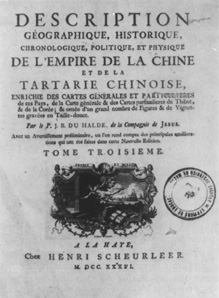 Frontespiece with allegorical medallion.
In: DU HALDE, Jean-Baptiste, S. J., Description Geographique, Historique, Chronologique, Politique, Et Physique, De L'Empire de la Chine et de la Tartarie Chinoise, [...], 4 vols., Haye, Chez Henri Scheurleer, 1736.4 vols, vol. 3, title page.
Frontespiece with allegorical medallion.
In: DU HALDE, Jean-Baptiste, S. J., Description Geographique, Historique, Chronologique, Politique, Et Physique, De L'Empire de la Chine et de la Tartarie Chinoise, [...], 4 vols., Haye, Chez Henri Scheurleer, 1736.4 vols, vol. 3, title page.
In 1605, thanks to the intervention of of Zhao Bangjing, of the Ministry of Rites, Matteo Ricci was authorized to move from the Siyiguan (Foreigners Living Quarters) to the East of Xuanwumen, where he bought a large House with forty rooms, which he called Beijing Huiyam -- the present day Nantang (Church of the Sun). This became the meeting point for missionary activities in the capital.
In 1608, Lazzaro Cattaneo, who had meanwhile assumed the highest position of the Society of Jesus in Nanjing, was invited by Xu Guangqi and Li Zhizao to do missionary work in Shanghai, Hangzhou and Jiading. In the last twenty-five years, from 1580 to 1605, missionary activities in the interior of the country, or rather, the penetration of the Jesuits through Macao, had already permitted the creation of a positive situation for the missionaries, in China. Statistics reveal that in eighteen years, from the conversion of the first Catholic in Zhaoqing, by Ricci, and up to the year 1611, the number of Chinese converts to Catholicism in Guangzhou, Zhaoqing, Shaozhou. Nanjing, Nanchang. Hangzhou, Shanghai. Jiading and Beijing had reached two-thousand-five-hundred. 4 Besides Macao, Churches had been built in Zhaoqing. Shaozhou, Nanchang. Nanjing and Beijing, where thirteen European priests and seven Chinese Brothers were living. This situation established, so to say, the foundations that would enable the future expansion of Catholicism in China.
The success which Ricci and other missionaries met in establishing missions in a number of cities in China through Macao enthused the General of the Society of Jesus to increase the number of members of the Order to the interior of the Middle Kingdom. Macao remained as the "doorway" into China. With the objective of facilitating the future missionary activities of the recently arrived Jesuits, it was indispensable for them to learn how to read and write in Chinese, the country's social manners and its local customs. Alessandro Valignano thus presented a proposal to the Father General of the Society of Jesus, in Rome, requesting authorization to establish a University in Macao which would have the purpose of preparing and training these recently arrived members of the Order who would be sent to do missionary work in China and in Japan.
In 1594, the Provincial of the Society of Jesus, in Goa, António de Quadros, authorized Alessandro Valignano's request, and he ordered the Jesuit Superior, in Macao, to enlarge the College of St. Paul, converting it into a University, where courses such as Chinese, Latin, theology, philosophy, mathematics, astronomy, physics, medicine, rhetoric and music would be taught. The most important of these courses was, evidently, written and spoken Chinese. This was the first University that the Society of Jesus created in the Far East and it became a landmark through which Western Culture was propagated in China and Chinese Culture in the West.
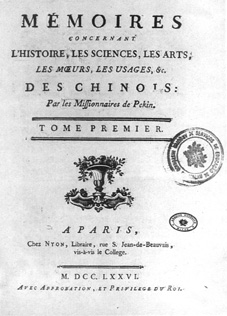 Frontespiece.
In: Mémoires Concernant l'Histoire, les Sciences, les Arts, les Mœurs, les Usages, & c. des Chinois: Par les Missionnaires de Pekin., Paris, Chez Nyon, 1776-1777, 2 vols, vol. 1, title page.
Frontespiece.
In: Mémoires Concernant l'Histoire, les Sciences, les Arts, les Mœurs, les Usages, & c. des Chinois: Par les Missionnaires de Pekin., Paris, Chez Nyon, 1776-1777, 2 vols, vol. 1, title page.
In the period of more than one-hundred-and-eighty years from 1594 (Wanli 22) to 1779 (Qianlong 44), the College of St. Paul always functioned as a training base where the Jesuits who were selected to enter China and Japan were prepared to their future missionary work. According to a statistic, of the four-hundred-and-thirty Jesuit missionaries who left Lisbon for Macao, two-hundred learned Chinese at this College and of these two hundred, one-hundred-and-thirty were sent to do missionary work in the interior of China. 5
In addition to the Jesuits, the great majority of the Franciscans, Dominicans and Augustinians who entered China to do missionary work also passed through Macao. The Kangxi and Qianlong Emperors arrived at the point of confirming that in order to be granted their right to be a missionary in China one had to "live more than two years in the Catholic church [sic], in Macao, in Guangdong [...] and learn the Chinese language."6 Just like the missionary workforce, the budgets for implementing the Catholic Faith were distributed amongst the different mission Churches, in China, from Macao. In fact, Macao remained the exclusive Catholic port of access to China, not only for the Company of Jesus but also for the other religious Orders who wanted to do missionary work in the Middle Empire.
Due to the intensification of Jesuit missionary activities in China, the number of Chinese Catholics progressively increased in a significant way during the one hundred-and-eight years from the end of the Ming Dynasty to the beginning of the Qing Dynasty. In 1585 (Wanli 13), statistics reveal that there were merely twenty Catholics in all of China, but that already in the following year this number had increased to forty and, in 1589 i had doubled to eighty.
In 1605, it suddenly went up to one-thousand; in 1615, to five-thousand; in 1636 (Chongzhen 9), to thirty-eight-thousand; in 1650, (Shunzhi 7) to one-hundred-and-fifty-thousand: in 1664 (Kangxi 3), to two-hundred-and-fifty-thousand; and in 1735 (Yongzhen 13), the number of Chinese Catholics totalled three-hundred-thousand. 7
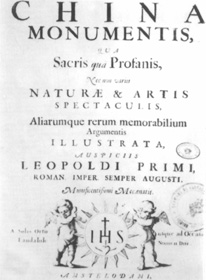 Frontespiece with monomark of the Society of, Jesus.
In: KIRCHER. Athanasius, S. J, China Monumentis. qua Sacris quà Profanis. Nec non variis Naturae et Artis Spectaculis. Auspiciis Leopoldi Primi. [...]. Amstelodami, Jacobum à Meurs. 1667, title page.
Frontespiece with monomark of the Society of, Jesus.
In: KIRCHER. Athanasius, S. J, China Monumentis. qua Sacris quà Profanis. Nec non variis Naturae et Artis Spectaculis. Auspiciis Leopoldi Primi. [...]. Amstelodami, Jacobum à Meurs. 1667, title page.
In this same period, innumerable Churches were built. In the last years of the reign of Chongzhen, Churches spread throughout the thirteen buxhengshis (Administrative divisions on the Provincial level) of the Empire. In 1660, there were thirteen Franciscan Churches; in 1664, twenty-one Dominican Churches and in 1667, one-hundred-and-fifty-nine Jesuit Churches. The above mentioned Churches were scattered through forty Municipalities and Districts, namely Beijing, Zhengding, Baoding, Hejian, Jiangzhou and Puzhou, in the Province of Shanxi; in Xi'an and Hangzhou, to the west of Shanxi; in Kaifeng, in the Province of Henan; in Chengdu, Paoning and Chongqing, in the Province of Sichuan; in Wuhang, in Huguang; in Hachang, Jiachan, Ji'an and Gazhou, in the Province of Jiangxi; in Fuzhou, Tingzhou, Yanping, Jianning and Shaowu, in the Province of Fujian; in Hangzhou, in the Province of Ahejian; in Nanjing, Yanzhou, Zhenjiang, Huai'an, Shanhai, Songjian, Changshu, Suzhou, Jiading, Taichang, Kunshan and Chongming, in the Province of Jiangnan; and in Macao, Zhaoqing and Shaozhou in the Province of Guangdong. 8 Taking this listing into consideration it is remarkable the speed and extent of the Catholic diffusion in China.
The objective of the Jesuits who went to do missionary work in China was "to make the Chinese and the other [recently converted] Christian peoples, recognize and venerate God [as] the true Divinity."9
"The people who came to the Orient were, in the majority, intelligent and generous people, [...] and the content of their books, mainly dealt with matters which the Chinese had never approached."10
"The Italian Jesuit Matteo Ricci and others who did missionary work through teaching of their scientific expertise brought [to China] knowledge which the Chinese did not possess and which was a recent novelty, even in the West. 11
The Jesuits' thorough investigation of Chinese Culture and Its promotion in their respective European countries came to contribute towards the development of the fundamental values of the Age of Enlightenment. Concomitantly, the Chinese clearly learned from the Jesuits, absorbing their scientific, technological and artistic knowledge thus promoting the development of Culture in China. Both Civiizations became mutually enriched by this exchange of information!
§3. THE DIFFUSION OF CHINESE CULTURE IN THE COUNTRIES OF WESTERN EUROPE THROUGH MACAO
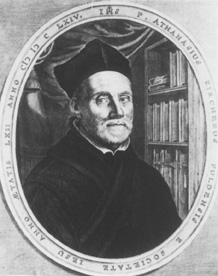 Athanasius Kircher, German scholar and inventor.
In: KIRCHER, Athanasius, S. J.; Trans. DALQUIÉ, F. S., La Chine d'Athanase Kirchere. De la Compagnie de Jesus, illustrée De plusieurs Monuments tant Sacrés que Profanes, Et de quantité de la Nature et de l'Art [...], Amstelodami, Johannem Jenssenium à Waesberge, 1670, p. 1.
Athanasius Kircher, German scholar and inventor.
In: KIRCHER, Athanasius, S. J.; Trans. DALQUIÉ, F. S., La Chine d'Athanase Kirchere. De la Compagnie de Jesus, illustrée De plusieurs Monuments tant Sacrés que Profanes, Et de quantité de la Nature et de l'Art [...], Amstelodami, Johannem Jenssenium à Waesberge, 1670, p. 1.
The diffusion of Chinese Culture in the West has a long history. After the middle of the sixteenth century, because the Jesuits entering into the interior of the country through Macao needed to speak the language of the country and know the ideology of Confucius, the study of the Chinese language as well as the translation and interpretation of the classic Confucian works was increasingly gaining importance. Because of this, the Classical Confucian works began to circulate and be disseminated in the countries of Western Europe. At the end of the eighteenth century (during the reigns of Qianlong and Jiaging), a real fever for Sinological studies swept Europe, from the Jesuits to European intellectuals in general. It was then that the Universities began to frequently hold conferences about Chinese matters and Academic Societies especially dedicated to Sinology began to appear. Chinese Culture began in this way to exercise a strong influence over European Culture.
3.1. The Ideology of Confucius Overwhelms Classical Philosophy of Western Europe
For the Jesuit missionaries who entered China with the objective of divulging the Christian Faith, it was important to know the traditional religions of China - Confuciusism, Buddhism and Daoism. Famous Jesuits, such as Matteo Ricci, demonstrated a special appreciation for Confucian philosophy; they did research into the life of the Master, they translated and interpreted the classical Confucian works and they wrote books explaining Confucian philosophy in their countries. In 1682 the Belgian Jesuit Philippe Couplet made the Classical Confucian works known to the countries of Western Europe through his work Confuncius Sinarum Philosophus, in four parts: (1) Letter of Philippe Couplet sent to the French King Louis XIV, (2) About the History and Principal Ideas of the Works Interpreted, (3) Biography of Confucius and (4) Daxue, Zhongyong and Lunyti, a work which was easily accepted by Western intellectuals. Afterwards François Noël wrote the Philosophia Sinica and translated the Sishu (The Four Books), Xiaojing (The Book of Filial Piety) and Youxue (Teachings for Children), making the results of his studies of Confucian ideology known in France. The Jesuits returned from Macao to Europe and offered the Classical Confucionist works to the German Gottfried Wilhelm Leibniz, who dedicated himself to the study of Classical philosophy and this awoke in him the profound interest of studying Chinese philosophy. In 1715, this German philosopher wrote a work entitled About Chinese Philosophy in which he expounded exhaustively on Chinese philosophy and Culture to the countries of Western Europe and praised the grandiosity of China's Culture:
"Among us, no one would believe that there exists in the world a nation with more perfect morals and principles of procedure more advanced than our own. China, a country of the Orient, came to remind us. With regard to the practice of Philosophy, the Europeans are very inferior to the Chinese."
Leibniz even appealed to to the cultured figures of Western Europe:
"I arrived at the conclusion that we have to ask the Chinese to send us people capable of informing us about the goal and practice of moral theology."12
And it was in this way, that having aborded the deist ideology of Confucianism, Leibniz created Preceptionism, a 'Classical' philosophy, which he transmitted to his disciple Christian Wolff. The latter further systemized rational philosophy, subdividing philosophy into ontology, cosmology, psychology, natural, moral, economic and political theology, and he considered that all the principles of philosophy could be established through mathematical deductive methods. Wolff's philosophical system was accepted by Emmanuel Kant, who created the basic 'Classical' philosophy in Germany, as it is known today.
3.2. The Diffusion of Classical Chinese Works in the West
Parallel to the their missionary activities in China, the Jesuits were translating and publishing Classical Chinese works and having them circulated among European intellectuals. In 1593, Matteo Ricci was the first to translate the Sishu (Four Books) into Latin, giving them the title Tetrabiblion sinense de Moribus. Ricci sent his work to Italy, where it was published. Subsequently, the Jesuits Prospero Intorcetta and Inácio da Costa once again translated the Four Books, also with the title Tetrabiblion sinense de Moribus, in which the Daxue was interpreted as Sapientia sinica and was published, in Jianchang, in 1662.
Jean-Baptiste Regis translated the Yijing, with the title: Roy, Antiquissimus Sinarum Liber, which appeared, in France, in 1839. Presently, in the Vatican Library there are fourteen different Chinese manuscripts of the Yijing.
In 1770, Antoine Goubil translated the Shujing, and published it in Paris.
Other Jesuits also translated or compiled a considerable number of dictionaries in Chinese and sent them to European countries where they were published; for instance, Basilio and Glemona com piled a Chinese-Latin Dictionary, Martino Martini translated and compiled a Grammatica Sinica and, in 1728, Joseph-Marie de Prémare wrote the Notitia Linguœ Sinicœ, later reaching an edition of 13,000 copies; These works greatly contributed towards the acceleration of learning of the Chinese language and Culture among European peoples.
3.3. The Diffusion of Chinese Literature in the West
The Jesuit Jean-Bapytiste du Halde's four volume Description Géographique, Historique, Chronologique, Politique et Physique de L'Empire de la Chine et de la Taratarie Chinoise, systematically presented to European countries the social sciences of China, becoming at the time, the standard encyclopedia about China. The third volume of this work includes selected prose from the Guwen Guanzhi (Appreciation of Old Prose Works) and French translations of masterpieces of Chinese literature such as L'Orphelin de la Maison de Tchao, tragédie Chinoise.
In 1761, appeared an English translation of the novel Haoqiuzhuan. Its public success was followed by other Chinese literary translations, namely the Summary of the Theatre in China, a Collection of Chinese Proverbs and Popular Sayings and Selected Chinese Poetry, spreading throughout the countries of Western Europe the jewels of Chinese literature and greatly influencing the European Enlightenment of the eighteenth century.
Goethe's play Elphenor based on L'Orphelin de La Maison de Tchao, tragédie Chinoise and on the Guwen Guanzhi was equally influenced by these works. It was highly praised by intellectuals in many different fields and moved the European readers.
3.4. The Diffusion of Chinese Medicine in the West
During their missionary activities in China, many Jesuits were attracted to the extraordinary traditional medicine of the Middle Empire and the medicinal products used in Chinese pharmacopoeia. They began studies and research in this field, and translated and compiled works about traditional Chinese medicine so that they could become known in Europe. In 1671, was published the French edition of Diagnosis through Feeling the Pulse in China. The third volume of Du Halde's above mentioned work, L'Empire de la Chine, contained excerpt translations of the Maijing - a Classic work on diagnosis through feeling the pulse -, the Bencao Gangmu (Compendium of Medical Science), Shennong Bencaojing (Compendium of Medical Science of Shennon), and a List of Famous Doctors and Collection of Medications. This publication widely contributed to make particular methods of Chinese medicine known to Europe.
From then on, Chinese medicine evolved in Western Europe as a novel branch of medicinal knowledge its studies, having great influence on zoology, botany and the Theory of the Evolution of the Species.
In the nineteenth century, Darwin, in his The Descent of Man, cited facts from the Bencao Gangmu about the mutation of colours in gold fish. At the beginning of the Qing Dynasty, this Chinese Classic, which explains causality in the problem of the survival of the species, had been translated into German, French, English, Latin and Russian. In the second chapter: Artificial Choice, of his Variation of Animals and Plants in Domestic Conditions, Darwin stated many times that he had consulted works edited by the Jesuits in the previous century, mainly, the great encyclopedic work of ancient China, the Bencao Gangmu. 13 A study revealed that in Darwin's works, there are one-hundred-and-four citations about events in Chinese medicine and Chinese theories of zoology and botany, 14 This study reveals the profound influence that these methods of Chinese medicine had both, on modern biology and in Darwin's Theory of the Evolution of the Species.
3.5. The Diffusion of Handicrafts and Fine Arts from China to the West
Traditional Chinese merchandise, such as silk, porcelain and lacquered objects have always been greatly appreciated in European countries. After the middle of the sixteenth century, these began to be transported by sea to Europe through the Macao-Goa-Lisbon maritime route. The handicrafts and fine-art products from China began thus to circulate in an ever-growing number of European countries. Many items were copied, while others were the object of study and theses, or themes for specialized books. In 1677, the Frenchmen Chardin and Pierre Chicaneau, opened a factory and after adaptating the Chinese methods to local technologies, managed to produce semi-hard blue-and-white porcelain objects with flower motifs.
In 1717 the Jesuit Fr. d'Entrecolles, a missionary in Jianxi, sent to France a sample of kaolin and, in 1750, the Duke of Turegon ordered the exploration of kaolin in France. In 1768, the porcelain factory of Sévres managed to produce, for the first time, hard procelains. Almost simultaneously, the English opened at Bow, the "New Canton Porcelain Factory" with three-hundred artists and craftsmen who managed to produce Chinese-like porcelain with equipment imported from Guangdong.
The Jesuits were also responsible for the introduction, in Europe, of the manufacture of wallpaper skills. In 1788, France managed to produce wallpaper according to Chinese methods. In 1734, a publication on Chinese wallpaper was published in England.
Thanks also to the Jesuits, Chinese architecture and pictorial Art were made known in Europe. In 1757, following his visit to China, the English architect William Chambers published Designs of Chinese Buildings, Furniture, Dresses, Machines and Utensils, which describes and illustrates the Chinese Art of architecture, furniture and dress decoration. In 1772, he wrote A Description of Oriental Gardening in praise of the Art of Chinese gardening:
"The Chinese art of gardening is truly incomparable. In the field of art, the Europeans cannot rival the successes of the Orient. They can, however, absorb to the maximum their brilliance, as if it came from the Sun."
In reality, the Jesuits who did missionary work in China, from the middle of the sixteenth century to the end of the eighteenth century, became the propagators and divulgers of Chinese Culture in European countries. Their works allowed the Europeans to better understand the Chinese Civilization, with its highly developed and prosperous Culture. In the Jesuits works for the European market, the Middle Kingdom Emperor was portrayed as being shrewd and competent, its people obeyedient and with well-established moral concepts and the country' s Culture one with a long history and profundity far surpassing the European highest standarts. Thus, the intellectuals and thinkers of Europe came to hold Chinese Culture in a distinguished position and a vogue of Sinological studies gradually took shape to become a major influence in the European bourgeois Enlightment thinking of the eighteenth century.
There were also those who, at the time, took up the idealist Confucian philosophy of the Song Dynasty to attack the European autocracy and oppose the Catholic Church. From this, one can see the enormous impact that Chinese Civilization and ideas had on the European Civilization. In the field of translations and compilations of Chinese Classic and religious works, the Jesuits played a preponderant role and, according to incomplete statistics, in more than two-hundred years of their presence in the Middle Kingdom - from 1593 until the early eighteenth century -, the Jesuit missionaries had already translated more than eighty-four Chinese works into Western languages.
§4. THE DIFFUSION IN CHINA OF WESTERN SCIENCES AND CULTURE THROUGH MACAO
According to the principle that "to go to China, [...] and preach the Holy Faith, books were necessary,"15 the Jesuits brought a large quantity of works from Western countries. In 1620, when Nicolas Trigault arrived in Macao, he brought with him "more than seven-thousand profusedly illustrated books,"16 which he took with him to China. More than five-hundred of these books are conserved today in the Beijing National Library. Of those seven-thousand books: "there [were] books on hydraulics, [...] there [were] books on mathematics, [...] there [were] annals and maps of foreign countries which escribed their folkore, lands and perilous mountains. There [were] books on medicine, which analyzed blood malfunctions, the human pulse and contemprary [medical] treatment methods. There [were] books on musical instruments, string and wind, all of which [were] originals. There [were] books on physics, which explained, in full detail, the laws and principles which reside both in things as well as in phenomena -which [contained] instructions for beginners. There [were] books on geometry, which analysed the square, the circumference, the plane and the right angle triangle, - which [contained] basic knowledge for the manufacture of instruments and objects. These above mentioned books were inexistent in our country."17
In fact, these books dealing with a broad spectrum of 'progressive' sciences which included astronomy, calendar, hydraulics, mathematics, geography, physics, geometry, medicine and music, undoubtebly became responsible for the scientific and technological development of modem China, where "the Jesuits managed to established themselves in China with the support of their expertise on mathematics."18
Let us therefre begin by examining the role of mathematics in a brief analysis of the diffusion of Western sciences and Culture, in China.
4.1. Mathematics
On the 10th of May 1605, Matteo Ricci indicated in a Report to the Pope, in Rome, that for the implementation of missionary work in China, Mathematics should be used to conquer the will of the people. 19 Thus, Ricci compiled, in a succint and clear language, the Quiankun Tiyi (In Spaeram João de Sacrobosco Commentarius) in two volumes, the first one being exclusively dedicated to mathematical subjects, namely: the line, the plane, the circumference and the ellipse. This was the first Western work on mathematics to be introduced into China.
In 1606 (Wanli 34), under the supervision of Ricci, Xu Guangqi translated Euclides' Elementorum Libri - 6 vols.
"The first volume deals with the triangle, the second with the line, the third with the circumference and the fourth with forms contained within or circumscribed by the circle; and the fifth and sixth [dealing] with the propositions."20
This Treatise introduced the rudiments of contemporary mathematical knowledge into China.
In 1607 (Wanli 35), Ricci and Xu Guanqi jointly translated the Principles of Measurement, which dwelt with the measurement of the right-angled triangle. In 1608 (Wanli 36), Li Zhizao translated under the supervision of Ricci the Trattato delle Figure Isperimetre, confirming and elaborating the theorems expounded in the Elementorum Libri. In 1613 (Wanli 41), Li Zhizao translated under the supervision of Ricci the Epitome Arithmeticœ Practicœ, in which the propositions, of differential progression and deduction were explained. This work was responsible for the introducion of modem Western arithmetic into China. Ricci and Xu Gangqi would later jointly collaborated in writing the Similarity and Dissimilarity of Measurement and Pitagoras' Theorem, explaining the methods for measuring a right-angled triangle.
In 1631 (Chongzhen 4), Giulio Aleni dictated to Zhai Shigu the Principal Methods of Geometry. In 1629 and 1631 (Chongzhen 2 and 4, respectively), Johann Terrenz translated the Great Measurement and the Secants Chart. In 1744 (Qianlong 9), Giacomo Rho translated the Complete Theorems of Measurement and Calculation through Counters, Nicolao Smogolenski wrote the Proportional Logarithm and the Tiambu Zhenyan and Peter Janous the Proportion between the Circumference of the Circle and its Diameter and Improved Method for Calculation of the Sine and the Inverse. All these works had a great influence on the development of modern mathematics in China.
Between the middle of the sixteenth century and the eighteenth century, calculations effected by abacus, ruler, small sticks and in written format were progressively implemented in China, the last three having been introduced from the West and belonging to the ambit modern mathematics' achievements.
Erudite Chinese thus began to understand and study modern Western mathematics and to combine it with traditional Chinese calculation methods; mathematicians gradually becoming equally proficient in both Chinese and Western mathematics and familiar with research works on these fields. Recent research on these matters conclusively ascertained that, at the beginning of the Qing Dynasty there were, at least, one-hundred-and-twelve Chinese scholars who dedicated themselves to the study of modern Western mathematics. 21 Several scholars wrote a number of works on the fusion of Chinese and Western mathematical praxis and theories.
Mei Wending, for example, who knew Chinese and Western mathematics well, wrote: Chousuan (On the Use of Calculating with Counters) - 3 vols., Pingmien sanjiaofa juyao (The Basis of Plane Trigonometry) - 5 vols., Fangcheng lun (Treatise on Equations) - 6 vols., Gougu juou (On the Right-Angled Triangle) - 1 vol., Jihe tongjie (Understanding Geometry) - 1 vol., Jihe bubian (Supplementary Text on Geometry) - 4 vols. Wang Sichan wrote: Xiaoan xinfa (The New Methods of Xiao'An) - 6 vols.; Li Zhiquan: Jihe jianyi (Geometry made Simple and Easy) - 4 vols. Du Zhigeng: Jihe lunyue (A Concise Treatise on Geometry) - 7 vols.
Nian Xiayo: Duishu yingyun (Applications of Logarithms) - 1 vol. and Duisho biao (Logarithmic Tables) - 1 vol.; Mao Zongdan: Gougu lice (Speculations on the Right Triangle) - 1 vol.; Chen Xu: Gougu shu (Statements on the Right Triangle) - 2 vols. and Gougu Yingmong (Introduction to the Right Triangle) - 10 vols.; Wang Yuanjun: Gougu yan (Amplifications on the Right Triangle) - 1 vol.; Chen Lu: Xiyan suanfa daquan (A compendium of Western Computing Methods) - 4 vols; Dai Zhen: Suanjing shishu (The Ten Mathematical Mannuals) -10 vols., Cesuan (On the Use of Calculation Rods) - 1 vol. and Gougu geyuan lun (Treatise on the Determination of Segment Areas [using right Triangles] and Segmental Areas) - 3 vols.; and Jiao Xun: (Adding, Subtracting, Multiplying and Dividing) - 8 vols., (Solutions for Extraction) - 1 vol., (Notes about Arches) -2 vols., (Notes about the Circle) - 2 vols. and (Notes about the Ellipse) - 1 vol. All these works were fundamental to the evolution of modern mathematics, in China.
4.2. Astronomy and the Calendar
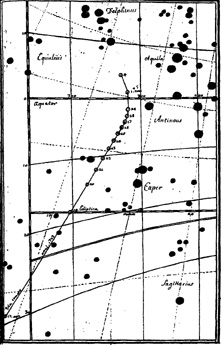 Celestial Chart.
In: GAUBIL, Antoine, Histoire Abregée de l'Astronomie Chinoise.
Celestial Chart.
In: GAUBIL, Antoine, Histoire Abregée de l'Astronomie Chinoise.
Astronomy and the calendar have a long history in China, with the first studies in this field dating from two-thousand years ago, a time in which the armillary sphere and the first books about the calendar appeared. Nonetheless, as it was not very scientific, the Chinese calendar needed to be elaborated each year. Matteo Ricci introduced into China the present Gregorian calendar, which had been revised and established by Pope Gregorio XIII, on the 1st of March 1582, and which was based on the Julian calendar. In About the Armillary Sphere, the first volume of the Qiankun Tiyi, cited above, Ricci explained in detail:
"The Sun's shadows, the Moon and the Earth provoke the solar and lunar eclipses; from the movements of the Sun and Moon result the shadows in conformance with the proportion of the Earth and the Sun, Moon, Mars, Mercury, Jupiter, Venus and Saturn, which previously was an ignored and rarely interpreted phenomenom, thus it does need to be explained in detail."22
In Zhaoqing, Ricci composed maps, constructed an armillary sphere, a terrestial globe, a device for throwing solar shadows and clocks which chimed hours, which presented to China the West's scientific knowledge about astronomy. Ricci even wrote the Jingtiantan, in which the stars already determined by the Western countries were collected and described in verse to facilitate their observation. In 1613 (Wanli41), Sabbatino de Ursis - after Ricci - dictated to Xu Guangqi the Jianping Yishou and later, dictated to Zhou Ziyu and Zhuo Erkang the Biaodushuo, a work meant to confirm the theory that "the earth is round and small".23
In 1615, Manuel Diaz wrote Discussions about the Heavens, reconfirming the theory that the Earth is round. From 1630 to 1644, Johannes Adam Schall, famous for the introduction of Western astronomy and calendar, in China, wrote sixteen works related to astronomy, namely the Analysis of Observed Eclipses, Chart of Eight Lines and Map of Two Stars in Movement to the North and South of the Equator, to cite only a few. Ferdinand Verbiest supervised the manufacture of nine astronomical instruments, namely the Ecliptic Armillary instrument, the Equatorial instrument, the Azimuthally instrument and the Celestial Globe, which were installed to replace the old ones in the Beijing Observatory. Verbiest also wrote the Collection of Astronomical Instruments and Astronometry - 16 vols., presenting in it the contemporary Western manufacturing methods for astronomical instruments, their assemblage and use, as well as astronomical data obtained with those instruments. He also compiled the Perpetual Calendar of Kang-xi - 36 vols., with the provision of astronomical data for the period of two-thousand years following the Kangxi reign, a work which provided important reference data for astronomy. Presentday studies in progress reveal that the Jesuits, in their two-hundred year presence in China, wrote a total of more than fifty works related to astronomy and manufactured thirty-four astronomical instruments. This clearly reveal the dimensions and profundity of the then modern Western astronomy made known in China.
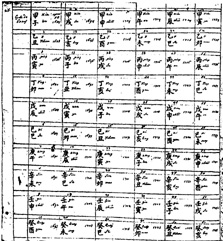 Chinese and Transliterated Listing.
In GAUBIL, Antoine, Histoire Abregée de l' Astronomie Chinoise.
Chinese and Transliterated Listing.
In GAUBIL, Antoine, Histoire Abregée de l' Astronomie Chinoise.
Under the influence of modern astronomy and the Western calendar a revision of the Datong Calendar was proposed to the Wanli Emperor and discussions were carried out in this subject. The Shoushi Calendar, established by Guo Shoujing during the Yuan Dynasty, stipulated that the year has 365.2425 days, with only twenty-six seconds less in relation to the time that the Earth needs to complete one revolution around the Sun. This was, in fact, the most scientifically correct calendar until the early fourteenth century. During the Ming Dynasty, the Xianzong Emperor substituted the Soushi it for the Datong Calendar which presented a great error difference and had a negative influence on agriculture. Later, many people requested a Department to be established to review the Chinese calendar according to the Western calendar.
In 1613, Li Zhizao, sub-director of the Taipusi (Administrative Department of Stud-farms), in Nanjing, presented to Shenzong Emperor a memorandum translating the Western Calendar and other Books, in which he stated:
"I discovered that the subjects who came from the West, Diogo de Pantoja, Nicolao Longobardi, Sabbatino de Ursis, Manuel Diaz, among others [...] know the calendar well, and they brought numerous books from their countries. There are books about astronomy which expound in detail about the phenomena of the Heavens and the Earth, as well as about the changes in natural phenomena. There are books about Sun clocks which are built on the land or on a wall, with marks to indicate the twenty four divisions of the solar year; in spite of the manufacturing differences, it is always maintained in compliance with the Heavens"24
In 1629, the Chongzhen Emperor ordered the foundation of the Western Department with headquarters at the Shoushan School, in Xuanwumennei, in Beijing. The Department was made up of Li Zhizao, Johannes Terrenz, Nicolao Longobardi, Johannes Adam Schall and Giacomo Rho, having Xu Guangqi as Minister of Rites, (being substituted by Li Tianjing, after his death) and Li Zhizao as adjunct Inspector. This Department had the duty of reviewing the calendar.
In 1635, the new calendar was published with the title Chongzhen Calendar or The New Western Calendar, which, in the Qing Dynasty, began to have the name New Methods' Calendar. This calendar was made based on the knowledge of contemporary Western astronomy and calendrical expertise with recourse to modern European scientific methods. It was an encyclopedia of astronomy and mathematics of great scientific value were solutions, methods, designs, charts, analyses, expositions and commentaries were presented in great depth. It had all the essence of a European calendar. 25
The Kangxi Emperor paid special attention to this calendar. When he discovered that the old calendar was not exact, he firmly decided to adopt the Western calendar and called the Jesuits who knew the Western calendar to the Court, namely Chirislain Herdtricht Christ, Filippo Maria Grimaldi and Tomás Pereira, for them to talk about astronomy and the Western calendar at any time during the twenty four hour day. The Emperor named, successively, fifteen Jesuits for the positions of Director and sub-Director of the Astronomical Bureau, amongst others Johann Adam Schall, Ferdinand Verbiest and Ignatius Kögler.
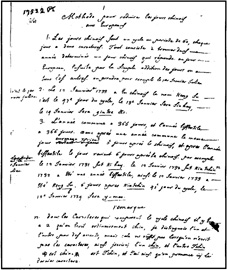 Methode pour reduire les jours chinois aux Europeans. Manuscript page.
In: GAUBIL, Antoine, Histoire Abregée de l'Astronomie Chinoise.
Gaubil was considered by many the most erudite of the Jesuit missionaries in China.
Methode pour reduire les jours chinois aux Europeans. Manuscript page.
In: GAUBIL, Antoine, Histoire Abregée de l'Astronomie Chinoise.
Gaubil was considered by many the most erudite of the Jesuit missionaries in China.
Thanks to the great interest shown by the Emperor in the Western calendar, the study and investigation of it spread among the intellectuals at a national level like a fever. A large number of astronomers, calendar specialists and publications about this material appeared. The Hungai Tongxian Tushuo, by Li Zhizao, was the first Chinese work to introduce the knowledge about modern Western astronomy in a systematic manner, in China. From that time, the Western theory which affirmed the sphericity of the Earth and stated that "the Earth spins" came to replace the traditional Chinese theory that "Heavens are round and the Earth square," as Liu Xuanting said at the time: "The theory that the Earth is round began to be known only after the arrival of Matteo Ricci in the Orient."26
During the reigns of the Kangxi and Qianlong Emperors, there were many scholars who became well acquainted with Western astronomy and calendars, writing books about the matter. For instance, Xue Fengzuo translated works of Nicolas Smogolenski. Ruo Yongyi, wrote Some Questions about Astronomy, Ruo Jiexuan: New Ideas about Astronomy, Jiang Yong: Yimei and Wang Sichan: New Methods of Xian' an and About the Calendar.
4.3. Geography and Cartography
When he lived in Macao and Zhaoqing, Matteo Ricci hung on the wall of his room a Map of the World which he had brought with him. The Mayor of Zhaoqing liked that map a great deal owing to its detail and he asked Ricci to translate it for him. Ricci thus made a copy of the map and added notes in Chinese. Known as the Map of the World, this was the first map authored by the Jesuit missionary, and it marked the beginning of the introduction into China of Western geography and cartography.
In 1602, at the request of the Shenzong Emperor, Matteo Ricci measured the longitudes and latitudes of Nanjing, Beijing, Hangzhou and Xi'an and made a special map which he called the Complete Map of the Countries of the Universe. In order to please Shenzong, Ricci placed China in the center of this map. This was the first world-map of China, drawn according to European cartographic methods, with longitudes and latitudes and with scientific knowledge about the five Continents (Asia, Europe, Africa, the Americas and Antartica) and the five "Zones" (Tropical, Southern Temperate, Northern Temperate, Southern Artic and Northern Artic). It allowed the Chinese to greatly increase their knowledge of the globe.
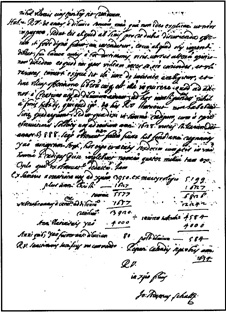
About the Reform of the Chinese Calendar, Autograph letter.
In: SCHALL, Johannes Adam, correspondence to the Vice-Provincial of China, Manuel Dias Junior.
Schall was given the assignment of reforming the Chinese calendar.
In 1605, Matteo Ricci compiled three more volumes for the Qiankun Tiyi, expounding on, not only, the sphericity of the Earth, but also knowledge about the geography of the five Continents and the five climatic "Zones"of the Earth. The work of the Italian missionary placed special emphasis on the explanation of the motives for the unfolding of the four seasons of the year and the alternation of days and nights. The longitudes and latitudes that Ricci used in his maps present scarcely minute differences with regard to present data; for instance, according to Ricci the Earth's radius was six-thousand-six-hundred-and-eighty-nine kilometers, which is close to the actual figure of six-thousand-three-hundred-and-seventy-eight kilometers, the names of the countries and the five Continents, as well as his theories about the geography of the five climatic "Zones" based on the division of the Earth on North and South Poles, the tropics of Cancer and Capricorn, and the Equator, remain invariable to the present.
Other Jesuits wrote detailed works on geography, climate, folklore and popular customs of multiple countries, as well as Treatises on a number of theories on geology, geography and the sphericity of the Earth. Of special importance were works such as Diego de Pantoja: Atlas of the Colonies, prepared for the Shenzong Emperor; Giulio Aleni: Zhi Fang Waiji - 6 vols. [1623, (Tanqi 3)], Ferdinand Verbiest: Atlas of the World [1674, (Kangxi 13)] and Explanation of the Atlas of the World [1672, (Kangxi 11)]; and Michel Benoist: Updated Atlas of the World.
During these two-hundred years, the Jesuits composed, in total, forty-three geographic and cartographic works, including a national atlas and seventeen Provincial atlases, specifically of Mongolia, Zhili, Heilungjiang, Shandung, Shanxi, Shaanxi, Gansu, Henan, Jiangnam, Zbejian, Fujian, Jiangxi, Guangdong-Guangxi, Sichan, Yunnan, Guizhou and Hubei-Hunan. It can be said that these works initiated cartographical studies in China.
In 1748, having been influenced by Western geography and cartography, the Emperor ordered that a Committee of cartographers be organized and be made up of the Jesuits Joachim Bouvet, Jean-Baptiste Régis, Pierre Jartoux and Xavier Ehrenbert Fridelli, and two Chinese scholars, He Guodong and Ming Antu. This Committee took ten years, from 1708 to 1718, to visit all the Provinces of China before editing the Huangyu Quantu or Huangyu Quanlantu (Complete Map of the Imperial Territories), at a scale of 1:140000, using the most contemporary modern methods: the topographic survey, the trignometric survey and the trapezoidal projection survey. At the time this was the most exact Atlas and the one that required the most work in all the World. This Atlas was not only "the best among all the existing atlases in Asia of the time, but also the best and the most exact among all those existing in Europe."27
In 1718, (Kangxi 57), this Atlas was printed in Europe, with bronze plates, and divided into forty-one maps by the Jesuit Matteo Ripa. One copy of this edition has been preserved in the Imperial Palace Museum, in Shenyang, under the title Secret Map of the Unified Territories of the Inner Qing Empire.
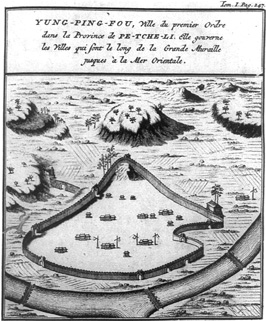
Yungpingfou, a town under the juridisction of the Northern Metropolitan Province (Beizhili).
In: DU HALDE, Jean-Baptiste, S. J., Description de la Chine, A La Haye, 1736, 4 vols, vol. 1, p.147.
In 1760, the Kangxi Emperor ordered Félix da Rocha, José d'Espanha and Michel Benoist to compile the Atlas of the National Territories of the Emperor Qianlong better known as The Qianglong Atlas of China. It was drawn at a scale of 1:1 500 000. It is a work with one-hundred-and-four maps being even more exact than the already mentioned Haungyu Quantu. This new atlas showed that the cartography in China had, by then, become among the most advanced in the World. 28
4.4. Western Medicine and Medical Materials
The introduction into China of Western medicine and medical science was begun with the establishment of the Western medical hospital in Macau by the Jesuits. In 1569, Melchior Carneiro raised funds in Macao to open "a hospital for all, believers and non-believers."29 This probably was the first Western medical hospital in China, which was called in the words of Zhan Rulin: "yrenmiao,"30 literally "house where the sick are treated." This hospital was baptized Baimahang (Santa Casa da Misericórdia). The hospital had internal medicine and surgery. In internal medicine, the patients underwent tests for urine colour, in addition to being diagnosed through feeling the pulse. The medications applied were all liquid preparations, which initiated the introduction into China of the Western practice of medications through distillation.
Xu Guangqi greatly appreciated Western medicines, about which he left explicit proof, upon saying:
"With regard to the application of Western medicines [...] what one takes is the essence of the medications, which can penetrate into internal organs including the heart, liver, spleen, lungs, kidneys, stomach, bile duct, intestines and bladder. 31
For the infirm undergoing surgical interventions there were famous medications long used in surgery, in the West. "Oil of Indian clove, oil of sandalwood and oil of the osmanto flowers, which were measured in a flask [...]."32
In 1755, the Franciscans also opened a hospital in Macao. 33
In 1820, John Livingstone, a doctor in the English Company of the East Indies, opened a Western medicine hospital in Macao; another doctor, named Thomas Richardson Colledge, opened a ophthalmological hospital in Macao which, according to registries which exist today, gave free assistance to six thousand infirm people for five or six years.
In the meantime, the vaccine against smallpox was also introduced into China through Macao. In October 1803, (Jiaqing 8), the Governor of the English colony of Bombay offered a quantity of vaccines against smallpox to the English Company of the East Indies, which were given as an experiment, for the first time in Macao, but without satisfactory results. In 1809, the English surgeon Alexander Pearson received a new shipment from Manila of the vaccine against smallpox and he gave the injections in Macao, this time with success, which led him to write an article about the matter. At the time, a Guangzhou businessman, Zheng Chongoian was in Macao, and he translated and transcribed the article of the English surgeon, calling it the Shocking Smallpox Vaccination, and he had it published in the interior of the country. In 1805, (Jiaqing 10), Alexander Pearson left for Guangzhou to practice medicine, and with funds offered by Wu Bingjian, Pan Youdu and Lu Guanheng, who were the richest men in the town. He established the department of smallpox vaccination, in Yanghang Huiguan. There, once every eight days, vaccinations were given, with one-million people in total having been vaccinated over a period of thirty years. Qiu Xi made frequent trips between Macao and Guangzhou to practice vaccination against smallpox, with the number of people vaccinated having increased greatly, as is stated in the Succint Registries of Smallpox Vaccinations: "The number of people coming there reached the hundreds."34 Due to its well-known effect, the vaccination against smallpox become rapidly known throughout the country.
In 1828, (Daoguang 8), the foreign Pan Shicheng established a Department of vaccination in Nanhai Hiuguan, in Beijing, headed by Yu Xingu, a native of Guangzhou. This medical Department became much sought out by local doctors who wanted to learn the principles and practise of vaccination. From that time on, vaccination against smallpox began to be administered throughout the country being well-received and even praised by the people, as testified in a poem by Wu Bingjian, a native of Nanhai:
"Man corrects the Heavens which are incompetent,
The will of the Heavens submits to man.
Abroad, the origin of the smallpox vaccine,
In the South of the country introduced and popularized.
The illness prevented, the appetite is there
The disaster expelled, health recuperated.
The ignorant parents are shocked,
But their babies are safe and sound.
With expert ability Qiu vaccinates [...]"35
Western medical theories and medical materials were also introduced into China. In 1594, Matteo Ricci wrote the Yuanbenpian and the Registry of the Western Countries - 1 vol. In it is written: "The memory is found in the cranial cavity under the occipital bone behind the fontanel [...]" Thus, the first step towards the introduction of neurology into China took place.
In 1620, Johannes Terrenz performed clinical pathological dissections after his arrival in Macao, in 1620.
In the following year, according to the dissection theories of Andreas Vessalius, a pioneer of dissection in Europe, he wrote Succint Analyses of the Human Body - 2 vols., the first of which presented the bones, musculature, skin, arteries and veins, blood and nerves, and the second was dedicated to the presentation of the nerve centre, mouth, eyes, nose, tongue, nerve centres for the limbs, action and speech, having also described in detail the shapes and positions of the organs. Thus began the introduction into China of the dissecton of the human body.
Later on, Giacomo Rho and Nicolao Longobardi translated and compiled the Illustrated Explanation of the Human Body, with twenty-eight chapters and twenty-one illustrations, in which they systematically presented the heart, liver, spleen, lungs, kidneys, stomach, bile duct, intestines, bladder, blood vessels, urine, uterus, embryo and navel. This was a reappraisal of the Succint Analyses of the Human Body and came signficantly contributed to a better understanding of the principles of dissection among the Chinese.
During Kangxi's reign, Western medicine entered into its practical phase in China. In 1693, the Emperor suffered successively from malaria, tumors on the lips and palpitations. The Jesuit Jean de Fontaney applied quinine to him and cured his malaria and then he applied other Western medications that resulted in the cure of his tumor and palpitations. From then on, the Kangxi Emperor began to have more confidence in medicine and products from the Western pharmacopoeia, and he named a considerable number of Jesuits specialized in Western medicine to be his personal doctors in the Court. In this regard, an historical registry states that:
"Kangxi fell into a state of profound suffering with a weak heart beating very rapidly, at the point of death. Luo De applied some medications to him and cured him, and he was named doctor to the Emperor of the Interior Court."36
With the spread of Western medicine and under the Emperor's influence, there appeared in China a number of doctors and scientists who were successful with Western medicine. Wang Honghan, for example, studied and aborbed the essence of Western medicine in the works by Giulio Aleni: Description of Sexology, Alfonso Vagnoni: Kongji Gezhi and Johannes Adam Schall: Zhuzhi Qunzheng and The Origins of Medicine (1688) - the first Chinese work about Western medicine. Schall became the first doctor to officially practise Western medicine, in China. Wang Qingren accepted the dissection theories that Matteo Ricci, Hieronymus Rho and Nicolao Longobardi expounded respectively in Succint Analyses about the Human Body and Illustrated Explanations of the Human Body and he wrote, in 1830, (Daoguang 10), Correction of Medicine - 2 vols., in which he expounded the theory of determination of causes of illness and processes of treatment through a dissecting autopsy. The theories and techniques he taught were based on the combination of Western medicine with Chinese medicine, with Chinese medicine becoming more scientific.
4.5. Physics
Modem Western physics was also introduced into China by the Jesuits. In 1627, upon arriving in Macao, Johannes Terrenz dictated and Wang Zheng translated and illustrated the Explanations of Strange Devices of the Far East - 3 vols., which describes the basic principles of modem physics, such as the laws of gravity, specific gravity, the lever, the return pulley, the spiral and the oblique plane, as well as methods of application of mechanics. This was the first work to introduce the modem physics of engineering from the West into China. 37
In 1620, (Wanli 48), Johannes Adam Schall brought a telescope to Macao and, in 1626, wrote in Chinese, About the Telescope, in which he presented in detail the functions, principles, and techniques for manufacture of this optical instrument - thus introducing into China the modern science of optics from the West.
In 1634, Johannes Terrenz gave a telescope to the Chongzhen Emperor which provoked great excitement in the scientific areas of China. At the beginning of the Qing Dynasty, the telescope was already widely known in Macao. Gu Dajun wrote: "through the telescope, you can see the top of the tower from fifteen kilometers distance with the bells and chords clear and all the characteristics distinguishable."38
In 1642, Sabbatino de Ursis wrote Hydraulics of the Great West - 6 vols., in which he collected the basic principles of modem hydraulic European engineering and expounded, for the first time in China, the "method for water gathering and extraction."39 Having studied the work of Sabbatino de Ursis and based on knowledge about hydraulics originating in China, Xu Guangqi compiled the Complete Book of Agriculture -60 vols., volumes Twelve and Twenty following the Hydraulics of the Great West, systematically and practically expliciting the modern Western technologies for the construction of reservoirs.
4.6. Architecture
It was through Ecclesiastic constructions, in Macao, that the Jesuits introduced Western architecture into China.
According to statistics, from 1561 (Jiaqing 40) to 1755 (Qianlong 20), the Jesuits built several Churches in Macao, namely, St. Paul's, St. Lazarus, St. Joseph and Nossa Senhora do Amparo [sic]. The majority of these Churches were stylistically 'modern' structures built according to Western prototypes with "three raised floors, round, triangular, quadrangular, hexagonal or octogonal, or like flowers and fruits, all having spiral roofs."40 [sic]
The most representative of these Churches in Macao was that of St. Paul's. Its facade, displayed sixteen massive columns. Its roof had a round dome at its crossing with its apex in the shape of a pyramid. [sic] This construction with its deep and wide hall resulted from a Chinese traditional structure blended with Western Classical and Baroque architectural styles.
In 1835, the Church was hit by lightening and consequently, destroyed by fire, only surviving its stone facade. It presently stands as a symbol of Macao and as a renewed source of Cultural debate.
During the Qing Dynasty, the commercial constructions of the Shiasanhang were built, in general, according to the style of this Church.
The most extravagant examples of European architectural styles imported to China were to be found at the Changchunyuan (Garden of the Long Spring), in the Yuanmingyuan Imperial grounds, immediately North of Beijng. The Changchunyuan was planned, in 1747, by the Italian Jesuit Giuseppe Castiglione its construction being supervised by the French Denis Attiret and Michel Benoist. Its architecture perfectly combined the Italian Baroque and the Classic French contemporary styles. The Xiyanglou - a set of follies planned by Castiglione - was made up of twelve extravagant constructions in the architectural style of Western Europe, in which the Dashuifa (Water Games) were an important feature. Other major attractions were the Chushuilou (Pavilion for gathering Waters), the Xieqiqu (Pavilion of Delight and Harmony), the Haiyuantang (Pavilion of the Calm Sea), the Guanshuifa (Pavilion to Contemplate the Waters), the Yangquelong (Sparrow's Aviary), the Fangwaiguan (Fangwai Temple), the Yuanyingguan (Yuanying Temple), the Huayuanmen (Garden Gate), the Xingting (Stroller's Kiosk) and the Xianfashan (Perspective Hill) In this Western garden-complex, yet in its structure so typically Chinese, were apparent the influences from the French Royal palaces and extensive parks of Versailles and Saint-Cloud, as well as the bizarrerie of Southern Baroque Italian constructions landscaped grounds.
Through the ambitious scale and exoticism of its novel edifices, the Yuanmingyuan thus became an unprecedented structure in World history of the architecture of palace gardens.
In 1743, in a letter sent to M. d'Assant, Denis Attiret praised the Yangmingyuan as the "Garden of Gardens." In the introduction to a poem specifically composed in praise of the Yuanmingyuan, the Qianlong Emperor wrote:
"Using a Western hydraulic method, water is pumped into a great room connected to a waterfall. [The sound of] water appears to derive from a musical instrument [...] Without strings or holes for blowing, its humming can be heard from far away, and it makes things turn green once again and it gives vitality to the scenery. 41 In 1933, Qi Gu in his Vestiges of the European Style Constructions in the Yuanmingyuan, systematically expounded on the styles and particularities of the European architecture of the Imperial Country Palace grounds' constructions.
4.7. Linguistic and Phonetics
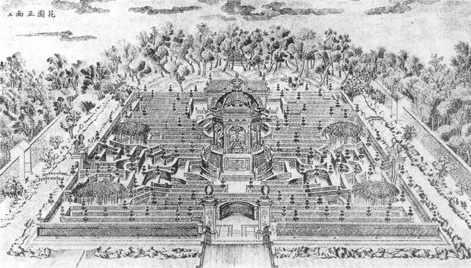
Huayuanmen (Garden Gate), a labyrinth at the Yuanmingyuan.
One of a Collection of eighteen century Engravings. Bibliothèque Nationale, Paris.
In Chinese, language writing is expressed via characters and not - as in the West - letter, each character having a different pronunciation. In order to overcome the multiple difficulties of studying Chinese encountered by the first Catholic missionaries, the Jesuits Matteo Ricci and Michele Ruggieri compiled, in 1584, the Portuguese-Chinese Dictionary. This dictionary phonetically notates Chinese characters in Roman phonems, thus structuring the pronounciation of each character as a coded phonem. This was the first attempt made to notate Chinese characters in direct relation to the Roman alphabet. In their dictionary's phonetic notation Ricci and Ruggieri used twenty-six "consonants", forty-three "vowels", four "secondary sounds" and five "tonal accents". Each Chinese character was marked with "consonants" and "vowels" and one of five accents: qingping, zhuping, shang, qu, and ru. 42
In 1605, (Wanli 33), Ricci wrote, in Beijing, the Miracle of the Western Letters, the first book to systematically use the Roman alphabet to phonetically notate Chinese characters.
In 1625, (Tianqi 5), based on Ricci's work Nicolas Trigault compiled the Xiru Ermuzi - 3 vols., a Chinese dictionary with phonetic notations even more systematically structured than the Miracle of the Western Letters. He also transcribed Chinese characterss into Romanic script. 43 This dictionary was composed of three parts as follow: an Introduction to Translation, a Phonetic Listing and a List of Component Characters. The dictionary was ordered according to the form, pronunciation and meaning of listings of selected Chinese characters:
"The first volume deals with [the structure of Chinese] writing and the translating [process]; the second lists Chinese characters ordered according to pronunciation and the last, lists Chinese characters ordered according to their components' number of strokes, accompanied by phonetic notes in Romanic letters".
This dictionary, in which a character may be found indexed to its pronunciation, used a total of twenty-nine letters representing diverse phonems, subdivided into five "vowels" and twenty "consonants" plus four more "secondary consonants" derived from basic Latin. By joining a respective "consonant" to the "vowel" any required character can thus be pronounced with this dictionary,
The dictionary not only came to facilitate the learning of the Chinese language in the West but exercised profound and direct influence on the phonetic transliteration of the Chinese characters.
An evident historical influence of this dictionary transpires in the practical appeal published, in the first years of the Chinese Republic, by the linguists Li Jinxi, Qian Xuantong, Zhao Yuaren and Lin Yutang, for the letters of the Roman alphabet to be used in the phonetic transcriptions of Chinese characters.
4.8. Philosophy and Morals
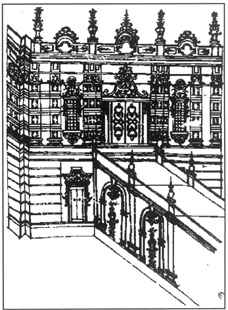
Unidentified pavilion at the Yuanmingyuan.
GIUSEPPE CASTIGLIONE. Drawing.
Possibly an unbuilt folly.
In May 1617, a religious conflict took place in Nanjing. As a result of this conflict, the Jesuit Alfonso Vagnoni was detained by Shen Que and expelled to Macao, where he lived for two years. Vagnoni dedicated that time to writing Questions and Answers about Philosophy - 2 vols., and the Kongji Gezhi, a Treatise which philosophically dwell with theories related to the so-called Four Elements of the Universe, namely: Fire, Air, Water and Earth. Vagnoni was, as a result of these works, the first Westerner to introduce into China, Western Greek philosophy.
In 1623, Giulio Aleni wrote the Description of Sexology, in which he expounded the philosophical principles which sought to explain the functioning of the human feelings, psycho, dreams and, ultimately, soul. Francisco Furtado and Li Zhizao jointly translated and edited two works: the Huanyouquan - 6 vols., and the Analysis of Famous Theories -10 vols. While the first book was a theorethical approach on the interpretation of the Universe according to Aristotle, the second volume, debated on a multiplicity of attitudes and viewpoints about morals. On the seventeenth century, despite the Analysis of Famous Theories being one of the most systematic works about European philosophy ever to be introduced into China, its influence remained practically insignificant owing to the widespread and strongly rooted influence of Confucian theories in the country.
4.9. Fine Arts
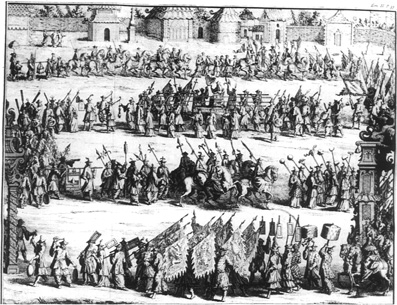
Cortege d'un viceroy, toutes les fois qu'il sort de son palais (Suite of a Viceroy, everytime he leaves his palace).
In: DU HALDE, Jean-Baptiste, S. J., Description de la Chine, A La Haye, 1736, 4 vols., vol. 2, p.35, detail.
When Matteo Ricci left for Macao, he took with him paintings of Lord Jesus and of the Virgin Mary. In 1600, (Wanli 28), he offered these portraits as presents to the Shenzong Emperor. This was the first recorded event of European fine works of art being admired in China. Gu Qiyuan, who lived in the capital at that time, compared these religious depictions to traditional Chinese paintings and considered that the Western pictorial compositions were made according to the principle of perspective, thus possessing advantages which Chinese visual renderings did not have. 44
The Jesuit painter Giuseppe Castiglione dictated to the mathematician Nian Xiyao the Optical Perspective. In China, his pioneering Treatise systematically expounded the theories and techniques of optical perspective applied to the practical context of Western painting. 45 This book became increasingly influential to a number of Chinese painters who immediately began to study and absorb the moods of Western painting. The combination of European perspective with traditional methods of Chinese painting came to create a new momentum in the Chinese arts. Zeng Qiong, a native of Fujian, perspectivated his paintings' compositions and increasingly energized his brushstrokes before applying the final colouring and perfecting his compositions' overall shading. His artistic methods were singular for his times and, in particular his portraits, appear alive and vibrant in contrast to China's contemporary traditional pictorial output. Zeng's particular artistic style had Chinese followers in the so-called "Jiangnan School" or the "South of the Yangtsé River School". His most talented disciples, Xie Bin, Guio Xun, Xu Yi and Shen Shao, developed the methods of Zeng Qing and considerably perfected his pictorial skills.
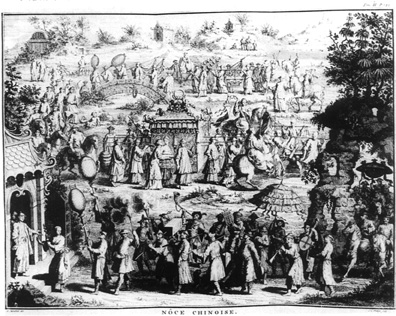
Nôce chinoise (Chinese wedding).
In: DU HALDE, Jean-Baptiste, S. J., Description de la Chine, A La Haye, 1736, 4 vols., vol. 2, p. 142, detail.
During the reign of Kangxi, the civil servant in charge of the Administrative Department of Stud-farms, Jiao Bingzhen, a native of Jining, as well as Leng Mei, Tang Dai, Chen Mei and Luo Fumin, also adopted perspective in painting. Thus there appeard many paintings with a mixed style-Western and Chinese.
The 1778, the Collection of Paintings of the Western Qing - 24 vols., edited by Men Yingzhao in the Xiqing Yanpu contained illustrations of some paintings in this Imperial collection. These compositions attest for a highly skilled technical level in the artificious use of chiaroscuro enhancing the volumetric renderings of the objects and the tangibility of the protagonists depicted.
Later, Western art came to influence even the most popular fine arts. In 1747 (Qianlong 12), the engravings inserted in the novel Xixiangi (The Dream of the Western Pavillion) were classified as being of a "similar style to Western painting." In chapter ninety-two of this literary work, the character Feng Zyiying asks the Jia family to sell him a screen decorated with a Chinese painting of a particular style which obeys to the laws of perspective characteristic of Western painting.
4.10. Music
Wang Linheng aptly described the introduction Western music was into China subsequent to the arrival of the Jesuits in Macao. This author says:
"A foreigner in Macao [...] manufactured a trunk and installed in it hundreds of sheng (a wind instrument made up of cane pipes) and reeds [...] and assembled a mechanism to activate them. When someone blows into a hole [in the trunk], the hundreds of reeds vibrate and their fast and slow rhythms are harmonious and their sounds are clear and pleasant."46 This instrument may be considered as an improvised organ at a time when organs were common in churches, in Macao. A contemporary document reads:
"At the St. Paul's Church, there is an organ installed in a trunk lined with skin, with a dozen wind pipes tied with silk strings, and an air box; and it is only necessary to gently blow into the air box, for the trunk to emit clear and rhythmic sounds, which are very pleasant to accompany [singing] verses."47
When Matteo Ricci arrived in Macao, he brought a Western musical instrument "which was three chi [approx. one meter] of width and five chi of length, with seventy two gold, silver and steel strings tied to pillars [sic], which emit sounds [...] when one touches them."48
In Beijing, Matteo Ricci gave this musical instrument to the Shengzong Emperor, and wrote a Set of Instructions for [this] Western Instrument so that the Emperor could play it, but instead, Shengzong ordered four people to learn how to play it.
Ricci gave the Shengzong Emperor another string instrument. It was "manufactured differently from those in China, with steel and iron strings, and it is [to be] played with a small blank instead of with the fingers and the sounds produced are clearer and more melodious."49
In addition to Matteo Ricci, the Jesuits Tomás Pereira, Teodoro Pedrini, Floriano Buhar, John Walter and Diego de Pantoja also knew how to play Western musical instruments. In the first years of Kangxi's reign, Ferdinand Verbeist recommended Tomás Pereira to the Emperor and, in 1674, Kangxi called him from Macao to serve in the inner Court of Beijing. Pereira proved to be so talented playing Chinese musical pieces that once the Emperor presented him with a brocade as a prize.
The Emperor liked Western music and called Teodoro Pedrini to the Imperial Palace for him to begin to teach musical theory to the Princes. The Historical Annals register that:
"[...] on the 22nd of June, (Kangxi 53), Chief Zhang Qilin transmitted an Imperial notice [which stated]: the Westerner Teodoro Pedrini is to teach his disciples not only to play but also, and more importantly, the essence of musical theories. If I were to need people who could play,
what type of persons who know how to play would I want? See this child who does not even understand the six notes do, ré, mi, fá, sol and lá? What did he teach him? Tell Teodoro Pedrini explicitly that he must teach them well, that he must teach them all the fundamental and most important musical theories."50
Thus Teodoro Pedrini lived for five years serving in the Imperial Palace, dedicating himself specifically to teaching Western musical theory to the Princes. The six notes, dó, ré, mi, fá, sol and lá, referred to by the Kangxi Emperor, were the notes used at that time.
The seven notes, dó, ré, mi, fá, sol, lá and si, which are used nowadays, evolved from the six notes introduced into the West. In 1713, in order to facilitate the teaching of musical theory to the Princes, Teodoro Pedrini in cooperation with Tomás Pereira wrote the Lü Zhengyi (Musical Temperament), in three chapters: the Zhenglü Shenyin (Correct Temperament), the Hesheng Dingyue (Determination of Tonality), and the Xieyunu Duqu (Harmony of Sounds), the last being particularly dedicated to the study of Western musical theories, which they had introduced most recently, in China.
In 1699, owing to his fondness of Western music, the Emperor created a small Western musical band at Court, with Tomás Pereira as head musician and the Jesuits Leopold Liebsteins and Slaviczek accompanying him.
This way, wind and string instruments as well as Western orchestral music were introduced into China. Western music could equally be heard in Churches, in different localities of the country. Zhao Yi, who describes in detail how well orchestral music was received by the congregation in the Beijing Sun Church, stated:
"There is a building in which music is played; in which an old man with a long beard is seated playing an instrument accompanied by sheng, xiao (vertical bambu flute), qing (an ancient percussion instrument of precious stone), bamboo flutes, bells, drums, nao (plates) and zhuo (an ancient military instrument in the shape of a bell)."51
In order to develop orchestral music, some Jesuits introduced Western musical theories into the composition of Chinese music. Floriano Buhar and John Walter, for example, composed sixteen works of Western and Chinese music to be played at the Court. In 1760, the Jesuits organized a band which played in the Court, the opera Cecchina, at the time widely popular in Rome and known throughout Europe.
What has been mentioned in this article sought, with some detail, to refer to the introduction into China of Western Culture spaning the period from 1584 to the end of the eighteenth century. It summarizes information collected from a plethora of works authored by Jesuits. During this period, and without counting literary works of a specific Christian religious content, the Jesuits who lived in China wrote an approximate total of one-hundred-and-eighty-seven varied scientific and Cultural literary works. Of these, one-hundred-and-two were published during the Ming Dynasty and eighty-five during the Qing Dynasty. Sixty-two of these works are presently on deposit at the Library of Xujiahui, in Shanghai. As a testament of the Cultural reciprocity between China and the West, these literary relics continue today to be a treasure of inestimable value for the study and research of the process of Cultural exchange between China and the West.
LIST OF WORKS
Cesuan (The Ten Mathematical Manuals) 策算
Chousuan (On the Use of Calculating with Counters) 籌算
Duishu biao (Logarithmic Tables) 對數表
Fangcheng lun (Treatise on Equations) 方程論
Gougu geyuan lun (Treatise on the determination of Segment Areas [using Right Triangles and Segmental Areas]) 勾股割圖論
Gougu juou (On the Right Triangle) 勾股舉偶
Gougu lice (Speculations on the Right Triangle) 勾股蠡測
Gougu shu (Statements on the Right Triangle) 勾股述
Gougu yan (Amplifications of the Right Triangle) 勾股衍
Gougu yinmong (Introduction to the Right Triangle) 勾股引蒙
Jihe tongjie (Understanding Geometry) 幾何通解
Jihe bubian (Supplementary Text on Geometry) 幾何補編
Jihe jianyi (Geometry made Simple and Easy) 幾何簡易
Jihe lunyue (A Concise Treatise on Geometry) 幾何論約
Duishu Yingyun (Applications of Logarithms) 對數應運
Pingmien sanjiaofa juyao (The Basis of Plane Trignometry) 平面三角法舉要
Puhua zidian (Portuguese-Chinese Dictionary) 葡華字典
Qing neifu yitung yudi mitu (Map in the Collection of the Inner Qing Court) 淸內府一統輿地秘圖
Qing yi xiyang lifadengshu shu (A Supplication made to the Emperor for the Translation of Western Calendrical Books) 請譯西洋歷法等書疏
Shixue (Optical Science) 視學
Suanjing shishu (On the use of Calculation-Rods) 算經十書
Tiangnan huapai (Questions on Astronomy) 天經或間
Jiangnan Huapai (Southern School Paintings) 江南畫派
Xiaoan xinfa (New Methods of Xiaoan) 曉庵新法
Xietan xinhua (New Discussions on Astronomy) 寫天新法
Xiquo jifa (Numerical Notations of the West) 西國記法
Xiyang suanfa daguan (A Compedium of Western Computing Methods) 西洋算法大全
Yixue yuanshi (The Origins of Medical Science) 醫學原始
CHINESE GLOSSARY
Baimahang 白馬行
Bencao Gangmu 本草綱目
Biaodushuo 表度説
Changchunyuan 長春園
Chen Mei 陳枚
Chen Wenfeng 陳文峰
Chongning 崇寜
Chongzhen 崇禎
Chushuilou 蓋水樓
Daxue 大學
Fanwaiguan 方外觀
Fang Yizhi 方次智
Gu Qiyuan 顧起元
Guanshuifa 觀水法
Guo Xun 郭汛
Guo Yingpin 郭應聘
Guwen Guanzhi 古文觀止
Haiyantang 海晏堂
Haoqiuzhuan 好俅傳
He Guodong 何國楝
Hesheng Dingyue 和聲定樂
Huangyu Quanlantu 皇輿全覧圖
Huangyu Quantu 皇輿全圖
huayuan men 花園門
Hudong Xianfahua 湖東線法畫
Hungai Tongxian Tushuo渾蓋通憲圖説
Jiading 嘉定
Jiajing 嘉靖
Jiang Yong 江永
Jianping Yishuo 簡平儀説
Jiao Bingzhen 焦秉貞
Jining 濟寧
Jingtiantan 經天談
Kongji Gezhi 空際格致
Leng Mei 冷枚
Li Jinxi 黎錦熙
Li Jizao 李之藻
Lin Yutang 林語堂
Liu Jiwen 劉繼文
Liu Xiting 劉獻廷
Longqing 隆慶
Lu Guanheng 盧觀恆
Lu Zhengyi 呂正義
Luo De 羅德
Luo Fumin 羅福旻
Lunyu 論語
Maijing 脈經
Meiling 梅嶺
Mei Wending 梅文鼎
Men Yingzhao 門應兆
Ming Antu 明安圖
Nanchang 南昌
Nanhai Huiguan南海會館
Nanjing 南京
Nantang 南堂
Nan Xiyao 年希堯
Nao 鐃
Pan Shicheng 潘仕成
Pan Youdu 潘有度
Qi Qu 奇趣
Qian Xuantong 錢玄同
Qiankun Tiyi 乾坤體儀
Qiu Xi 邱熹
Qu Taisu 瞿太素
Ruo Jiexuan 若揭喧
Ruo Youyi 若游藝
Shaoguan 韶關
Shaoxing 紹興
Shaozhou 詔州
Shen Shao沈韶
Sheng 笙
Shennong Bencaojing 神農本草經
Shenyang 瀋陽
Shi Xing 石星
Shoushan Shuyuan [School] 首善書院
Shujing 書經
Sichuan 四川
Sishu 四書
Siyiguan 四夷館
Taipusi 太僕寺
Tongya 通雅
Wan Zhongming 王忠銘
Wang Honghan 王宏翰
Wang Pan 王泮
Wang Linheng 王臨亨
Wang Sichan 王錫闡
Wang Zheng 王徵
Wu Bingjian 伍秉鑑
Xianfashan 線法山
sheng xiao 笙簫
Xiaojing 孝經
XieBin 謝彬
Xieqiqu 諧奇趣
Xieyun Duqu 協韻度曲
Xingting 行亭
XiqingYanpu 西淸硯譜
Xiru Ermuzi 西儒耳目資
Xixiangji 西廂記
Xiyanglou 西洋樓
Xu Guangqi 徐光啓
Xu Yi 徐易
Xuanwumen 宣武門
Xuanwumennei宣武門內
Xue Fengzuo 薛鳳祥
Yanghang Huiguan 洋行會館
Yangquelong 養雀籠
Yijing 易經
Yimei 翼梅
Youxue 幼學
Yirenmiao 醫人廟
Yu Xingu 余心谷
Yuanbenpian 原本篇
Yuanmingyuan 圓明園
Zhao Bangjing 趙邦靖
Zhang Qilin 張起麟
Zhang Rulin 張汝霖
ZhaoYi 趙翼
Zhao Yuanren 趙元任
Zhaoqing 肇慶
Zheng Chongqian 鄭崇謙
Zhejiang 浙江
Zhenglü Shenyin 正律審音
Zhongyong 中庸
Zhu Shilin 祝石林
Zhuo 鐲
Zhuo Erkang 卓爾康
Zhuping
Zhuzhi qunzheng 主制群徵
NOTES
1PEI Huahang 裴化行著, Trans. XIAO Junhua 蕭溶華譯, Registers of the Catholic Mission in China in the 16th-century 天主敎16世紀在華傳敎志, p. 188.
2FEI Laizhi 費頼之著, Trans. FENG Chengjun 馮承鈞譯, Biography of the Jesuits Who Arrived in China 入華耶穌會士傳, p.34.
3 SHEN Defu 沈德符, Collection of the Unofficial Tales from Wanli's Reign 萬曆野獲編, vol. 30.
4DE Lixian 德禮賢, History of the Catholic Missions in China中國天主敎傳敎史, p.60.
5WANG Zhixin 王治心, Concise History of Christianity of China 中國基督敎史綱, p.101.
6CHEN Heng 陳垣, Diplomatic Documents between Kangxi and Rome; Note on the Detention of the Westerner Fang Jifue by the Governor of Fujian, Ya De 康熙與羅馬使節關係文書, Military Archives 福建巡撫雅德拏獲西洋人方濟覺筆摺, p.5.
7SHEN Fuwei 沈福偉, History of the Cultural Exchange between China and the West 中西文化交流史, p.373 ff.
8WANG Zhixin 王治心, op. cit., pp.125-128.
9Zhonguo Congbao 中國叢報 Collection of Chinese Newspapers, 1836.
10Foreign Countries-Italy 外國傅、意大利, in: "History of the Ming Dynasty" 明史, vol. 326.
11ZHOU Yang 周揚, The Three Great Ideological Liberation Movements 三次偉大的思想解於運動, in: "Guangming Ribao" 光明日報, (8) May 1979.
12SHEN Fuwei 沈福偉, op. cit., p.449 - Quoting DENTENS, Opera Omnia, vol. 4, part. 1, pp.78-86
13Collection of Commentaries from the North 北方論叢, 1981, no[deg] 4, p.109.
14PAN Jixing 潘吉星, Diffusion of Chinese Culture and its Influence on Darwin 中國文化的西漸及其對達爾文的影響, in: "Science" 科學, Oct. 1959.
15PEI Huahang 裴化行著, Trans. WANG Changshe 王昌社譯, Father Matteo Ricci and His Contemporary Chinese Society 利瑪竇司鐸和當代中國社會, vol. 2, p. 216.
16YANG Tingiun 楊廷筠, Daiyipian 代疑篇, in: YANG Zihen 見楊振鍔, "Biography of Sir Yang Qiyuan" 楊淇圓先生年譜.
17XU Wending 徐文定, The Complete Works of Xu Wending 徐文定公集, vol. 60.
18WEI Te 魏特著, Trans. YANG Bingchen 楊丙辰譯, Biography of Johann Adam Schall von Bell 湯若望傳, vol. 2, p.422.
19RICCI, Matteo, Correspondence of Matteo Ricci, vol. 2, pp. 275-276.
20Siku Quanshu Zongmu Tiyao 四庫全書總目提要, vol. 106; cf: Astronomy and Mathematics: Agriculture 子部, 王文算法類工, vol. 115; cf: Catalogue of Strange Devices and Books 奇器圖書提要.
21ZHU Kebao 諸可寳, Biography of Three Erudites 疇人傳三編.
22See: Note 20 supra.
23See: Note 20 supra.
24FANG Hao 方豪, Biography of Li Zihizao, in: FANG Hao 方豪, "Biography of Historical Personalities of the Catholic Religion in China" 中國天文主敎史人物傳, vol.1, pp.118-119.
25See: Note 20 supra.
26LIU Xianting 劉獻廷, in:"Guangyang" 廣陽雜記, vol.2.
27LI Yuese 李約瑟, History of Science and Technology in China 中國科學技術史, vol.5, p.235.
28Huangchao Jingshiwen Sanpian 皇朝經世文三編, vol.49.
29Lettre de 1575 in: "Lettere" [sic], pp.215-217.
30Territory of Macao 澳門紀略, in: YIN Guangren 印光任 ZHANG Yulin 張汝霖, "Registos de Macau" 澳藩篇, vol. 2.
31FANG Hao 方豪, Collection of Commentaries on the History of Catholic Religion in China 中國天主敎史論叢, vol. 1, pp.118-119.
32See: Note 30 supra,
33Historical Register of the Diffusion of the Catholic Religion in China 天主敎流傳中國史科, in: "Collection of Documents" 文獻叢編, p.31.
34QIU Xi 邱熹, Introduction, in: CHEN Xinyman 陳修圓醫書, "Book of Medicine" 引痘略, p. 1.
35YUAN Liumo 淵六墨, Ed. WU Bingyong 伍秉鏞, Selected Poetry of Yuan Liumo 淵六墨妙詩鈔, vol. 2.
36The Relations between Kangxi and the Society of Jesus Registered in the Works Published in the West 閰宗臨: 從西方典籍所見康熙與耶穌會之關係, in: "Saodangbao" 掃蕩報, (4) 19 March 1941.
37See: Note 20 supra.
38QU Dajun 屈大均, Local Language of Macao 地語, 澳門, in: "New Words in Guangdong" 廣東新語, vol.2.
39See: Note 20 supra.
40See: Note 30 supra.
41XIANG Da 向達, History of the Exchange between China and the West 中西交通史, p.95.
42LUO Changpei 羅常培, Jesuit Contributions to the Phonetics 耶穌會士在音韻學上的貢獻, in: "Collection of the History and Linguistics Institute of the Central Academy of Research" 中央研究院歷史語言研究所集刊, vol.1.
43XU Zongyi 徐宗譯, Summary of the Works Translated by the Jesuits during the Ming and Qing Dynasties 明清間耶穌會士譯著提要, p.321.
44GU Qiyuan 顧起元, Superabundant Words by the Guest 客座贅語, vol.6.
45XIANG Da 向達, Books in Chinese Preserved in Oxford 記牛津所藏的中文書, in: "Review of the Beijing Library" 北平圖書館刊, Beijing, 10 (5) 1936.
46WANG Linheng 王臨亨, Registers of the Foreigners 粵劍篇, vol.3.
47See: Note 30 Supra.
48YEJIANG 樂, Complement to the Historical Documents 續文獻通考, vol.120.
49FENG Shike 馮時可, Pengchuang Xulu 蓬窗續錄 - Quoted in: FANG Hao 轉引方豪, "History of the Exchange between China and the West"中西交通史, vol.5, p.3.
50Kangxi e Theodoricus Pedrini 康熙與德里格, in: "Saodangbao" 掃蕩報, 23 April 1941.
51ZHAO Yi 趙翼, Zinfu Zaji 簷曝雜記.
AS SUPPLIED BY THE AUTHOR NOT CROSS REFERENCED IN THE COMPREHENSIVE BIBLIOGRAPHY
*Assistant Professor of History, Zhongshan University, Guangdong.
start p. 157
end p.